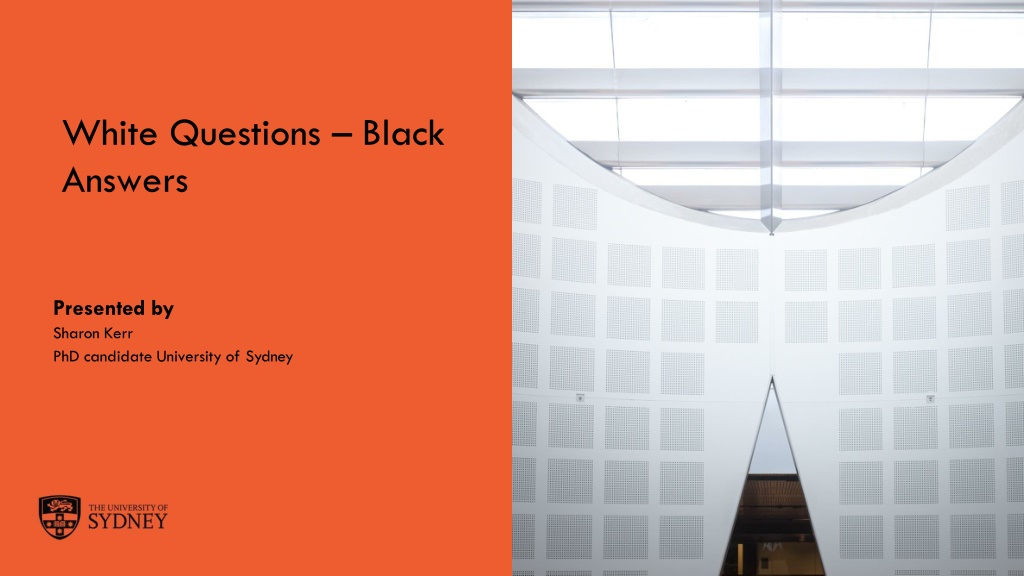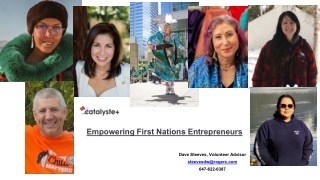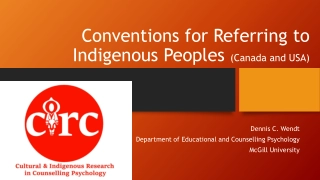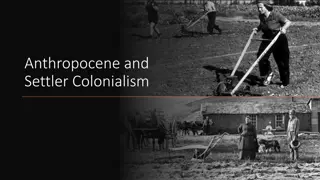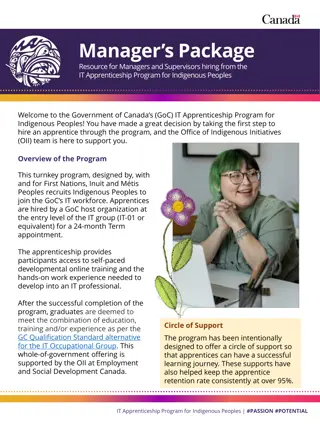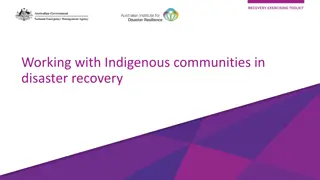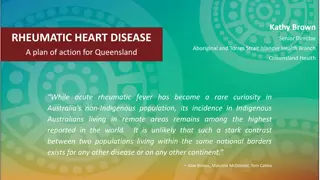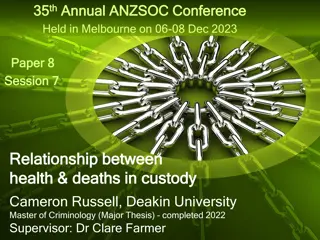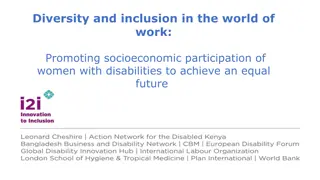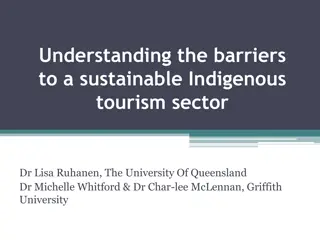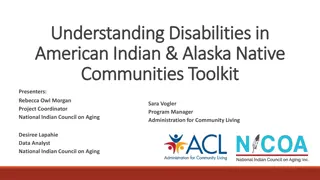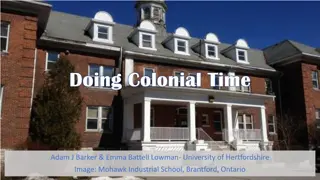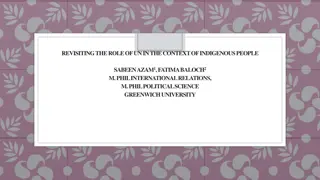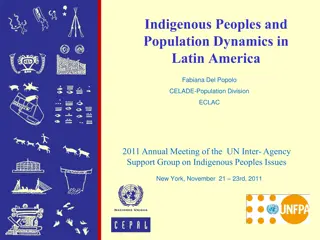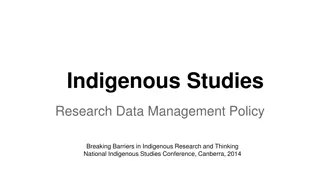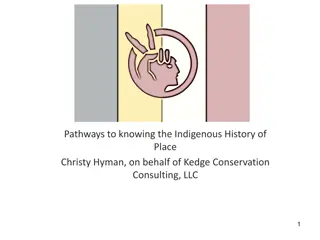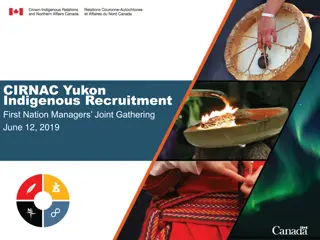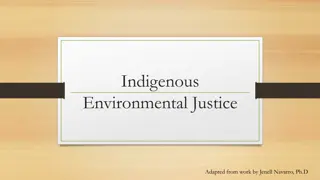Understanding Barriers Faced by Indigenous Students with Disabilities
This research project, presented by Sharon Kerr, a PhD candidate at the University of Sydney, delves into the challenges Indigenous students with disabilities encounter in accessing education and support. Through questions and data, the report sheds light on the barriers preventing these students from pursuing further studies and suggests ways to mitigate these obstacles for better educational outcomes.
Download Presentation

Please find below an Image/Link to download the presentation.
The content on the website is provided AS IS for your information and personal use only. It may not be sold, licensed, or shared on other websites without obtaining consent from the author. Download presentation by click this link. If you encounter any issues during the download, it is possible that the publisher has removed the file from their server.
E N D
Presentation Transcript
White Questions Black Answers Presented by Sharon Kerr PhD candidate University of Sydney The University of Sydney Page1
Acknowledgement Before I start I would like to acknowledge the traditional owners of the land on which we meet and elders both past and present. I would also like to acknowledge the traditional owners of the knowledge which I am going to share. In particular the input of Dr John Gilroy (my supervisor), members of my Indigenous Advisory Group: Roslyn Sackley, Maria Robinson and Naomi Carolin who continue to provide guidance and insight with regard to Indigenous knowledge and cultural safety; and people who have generously shared their stories with me for this research. The University of Sydney Page 2
White questions Black answers. As a teacher and a support practitioner I had a number of questions that I have set out to find the answers to. Some of these you may share: My questions: 1. Why it is that Aboriginal and/or Torres Strait Islander students with disability are not presenting for support? 2. What are the barriers both real and perceived for students who need support? 3. How can we mitigate the impact of these barriers? The University of Sydney Page 3
White questions Black answers. A report compiled by the Australian Institute of Health and Welfare (AIHW) (2011) using 2006 census data, examined responses from Indigenous adults with a disability and their attitudes towards further study and documented that: 30% of Indigenous Australians aged 18 64 years with the most severe levels of disability had wanted to pursue further study in the 12 months prior to survey and 13% were unable to do so because of caring or family reasons The University of Sydney Page 4
disability (ABS, 2018) The University of Sydney Page 5
White questions. Black answers. Multiple barriers exist for Indigenous students with a disability. These are different for each individual, thus the need to listen to your students and identify their needs. The University of Sydney Page 6
White questions. Black answers. From the literature barriers include: Poor access to quality education from preschool to year 12 Implication: students may have poor foundational learning skills The University of Sydney Page 7
White questions. Black answers. Unemployment Implications: both the world of education and the world of work may be foreign to the students and their families students may be studying in an environment of economic stress The University of Sydney Page 8
White questions. Black answers. Incarceration Implications: incarcerated students may not have access to the internet or the learning resources and support of other students personal, family or community experience with incarceration may impact on a student s personal confidence of succeeding at study and transitioning to employment and a career The University of Sydney Page 9
White questions. Black answers. Poor health and access to health services Implications: Students may be impacted by either their own poor health or the health of their family members for whom they carry carer responsibilities. The University of Sydney Page 10
White questions. Black answers. Accommodation Implications: Students may not have secure or appropriate accommodation conducive to studying. The University of Sydney Page 11
White questions. Black answers. Limited expectations. Implications: Students may not have mentors in their family and community that believe in their ability to succeed in higher education or have the capacity to encourage them at times of difficulty. The University of Sydney Page 12
White questions. Black answers. Cultural perspective of disability and cultural interface with higher education support services. Implications: students may not recognise that their particular challenge is labelled as a disability for which assistance is available students may not wish to identify and adopt what they perceive to be a deficit label The University of Sydney Page 13
White questions. Black answers. Cultural perspective of disability and cultural interface with higher education support services continued Implications: students may find the requirements for verifying their entitlement to support onerous students may not have undergone the testing required by support services The University of Sydney Page 14
White questions. Black answers. Access barriers relating directly to having a disability (both diagnosed and undiagnosed) Implications: students may not be aware that their education provider has a legal obligation to provide learning materials in an accessible format and therefore not seek alternative formats of texts to enable access. The University of Sydney Page 15
White questions. Black answers. Access barriers relating directly to having a disability (both diagnosed and undiagnosed) continued Implications: students may not be aware of the use of assistive technologies to enable access students may interpret their inability to engage with learning as a personal shortcoming rather than recognising that support is available for what may be a learning or sensory disability The University of Sydney Page 16
White questions. Black answers. Geographic location Implications: students may not have access to good public transport and may also have issues associated with not wanting to leave their families to go and study students may not have access to internet The University of Sydney Page 17
White questions. Black answers. Barriers for Indigenous students with a disability are multiple and real as institutions there is much we can do to support our students and mitigate the impact of these barriers. Let s take a look at the current approach of our institutions to supporting Indigenous students with a disability. The University of Sydney Page 18
White questions. Black answers. A 2016 audit of the websites and public information of Australia s 40 Universities revealed: - 35 of the university disability support services did not indicate support services available to Indigenous students. - Of the five universities that did indicate support services available to Indigenous students on their websites, three of these achieved this through the design element of having a link to all student services, including Indigenous student support services on the sidebar. The University of Sydney Page 19
White questions. Black answers. - One university included acknowledgement of country on every page of the website which hyperlinked through to the Indigenous student support page. - None of the 40 universities had information on their disability services website regarding the availability of Indigenous staff for students to contact. - 38 of the 40 universities had information about Indigenous support services. Two universities did not have any information. Both of these were private universities. The University of Sydney Page 20
White questions. Black answers. - 33 universities did not indicate support available for students with a disability on their Indigenous support services page . - None of the universities had information regarding male or female counsellors available for Indigenous students. - None of the universities had information regarding assistive technologies available to Indigenous students. - Only 7 of the universities had information regarding employment while studying for their Indigenous students. The University of Sydney Page 21
White questions. Black answers. On the positive side: - 34 Universities had supportive spaces for Indigenous students, - 35 Universities provided academic and administrative support, - 35 Universities provided tutoring for Indigenous students, - 34 Universities provided support with finances, - 28 Universities provided alternate entry pathways. The University of Sydney Page 22
White questions. Black answers. Only seven universities provided the opportunity for Indigenous students with a disability to present directly for help without supporting documentation. 33 universities required students to provide documentation from a specialist medical or allied health practitioner prior to the process for support being able to commence. (One university noted a ten step process for all students to proceed through in order to receive a Learning Action Plan (LAP), noting that once it lapsed, a new LAP would need to be applied for and secured prior to further assistance being given.) The University of Sydney Page 23
White questions black answers. What can my institution do to improve support? When we are speaking with our Indigenous students and their support networks we need to listen and be committed to responding appropriately. By way of example: - If our processes and requirements for support are creating barriers change them. - If there is a reluctance to be saddled with a deficit label don t insist on using them normalise the support requirements of the student offer assistive technologies the same as you may any other technology to support success (e.g. Grammarly ) The University of Sydney Page 24
White questions black answers. What can my institution do to improve support? - Work shoulder to shoulder with the Indigenous support staff in your institution to ensure that support is co-ordinated and responsive to the needs of your Indigenous students with a disability. - Ensure that all disability support staff are committed to ensuring a culturally safe support environment for Indigenous students with a disability and be aware of the perspective of disability held by Indigenous staff and students. - Don t forget the needs of part-time, distance and online Indigenous students with a disability. (Our responsibility is the same to them as it is our internal students.) The University of Sydney Page 25
References ABS. (2018). Disability, Ageing and Carers, Australia: Summary of Findings, 2015 ABS4430.0. Canberra: Commonwealth of Australia. AIHW,. (2011). Australian Institute of Health and Welfare : Aboriginal and Torres Strait Islander people with disability: wellbeing, participation and support IHW 45. Canberra: Commonwealth Government of Australia. Craven, R., & Dillon, A. (2013). Indigenous Australian Student's Participation in Higher Education and Potential Ways Forward. In R. Craven & J. Mooney, Seeding Success in Indigenous Australian Higher Education: (1st ed.). City The Emerald Publishing Group Limited. Craven, R., & Mooney, J. (2013). Seeding success in indigenous Australian higher education. London: Emerald Group. Day, D., & Nolde, R. (2009). Arresting the decline in Australian indigenous representation at university. Equal Opportunities International, 28(2), 135-161. Gilroy, J. (2015). The theory of the cultural interface and Indigenous people with disabilities in New South Wales. Balayi: Culture, Law And Colonialism, 10, 44 58. Gilroy, J., Donelly, M., Colmar, S., & Parmenter, T. (2013). Conceptual framework for policy and research development with indigenous people with disabilities. Australian Aboriginal Studies, 2, 42+. Harrison, L. (2014). Prisoners and their access to the internet in the pursuit of education. Alternative Law Journal,, 39(3), 159 162. Harrison, N. (2011). Teaching and learning in Aboriginal education. South Melbourne, Vic.: Oxford University Press. Kutay, C., Mooney, J., Riley, L., & Howard-Wagner, D. (2012). Experiencing Indigenous Knowledge Online as a Community Narrative. The Australian Journal Of Indigenous Education, 41(01), 47-59. The University of Sydney Page 26
